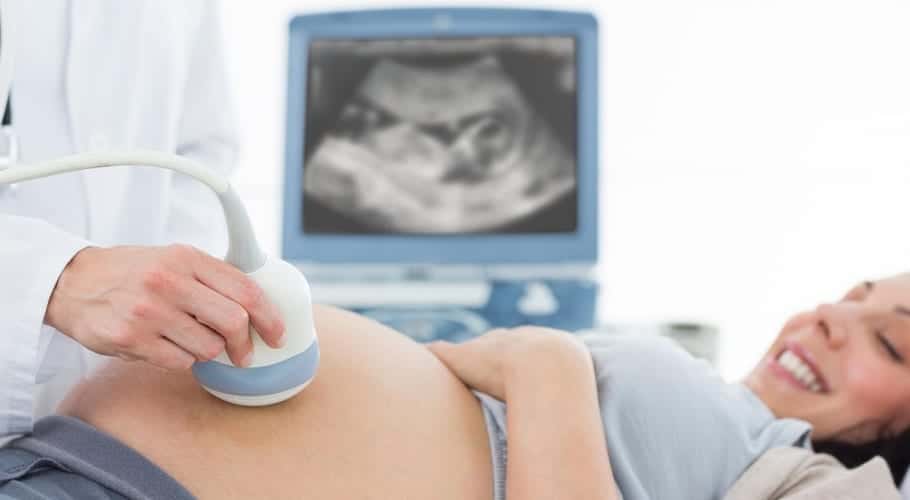
When a woman becomes pregnant she can know it through the pregnancy test or a blood test, but It will not be until the first ultrasound that you can assess and confirm that you are really pregnant and that everything is on the right track. For this reason the first ultrasound is such an important moment for any pregnant woman, it will be at the moment when they really assure her that she is creating life inside.
When a woman is pregnant (and the father too), she will wait with great anxiety for this special moment where they will hear the heartbeat of your little one as if it were a runaway horse to be able to feel, that in nine months, they will be able to have him in their arms. But what should you expect when you go for your first ultrasound?
What is an ultrasound?
A pregnancy ultrasound is a non-invasive diagnostic test that uses sound waves to create a visual image of the baby, placenta and uterus, as well as other pelvic organs. This will allow the healthcare professional gather valuable information about the progress of the pregnancy and the health of the baby.
During the test, the ultrasound technician (sonographer) transmits high-frequency sound waves through the uterus and bounces off the baby. The machine then translates this echo into video images that reveal the baby's shape, position, and movements.
When is the first ultrasound done?

The first ultrasound can be had between week 6 and 12 of pregnancy to be able to confirm it. But sometimes until after 9 weeks it is not possible to see if there is really an embryo forming because you cannot hear the heartbeat if it is too early. Normally the first ultrasound of pregnancy is in week 12 to 16. In Spain in public health, the first ultrasound is in week 12 of pregnancy, but it will not be from week 16 when they can tell you the sex of the baby.
If there are problems with the baby or you have any medical complications, the normal thing is that you not only do the ultrasounds established by the public health (which are usually 3), but they would have to do ultrasounds more often to check that everything is going well.
How it is performed?

To perform a pregnancy ultrasound, you will have to lie down on an exam table or on a stretcher. The technician will apply a space gel to the abdomen and pelvis area. This gel is water-based so it won't leave marks on your clothes or skin.. The gel will help the sound waves travel properly to create the image on the screen.
The technician will then place a small tube (transducer) on your belly. The technician will move you to capture the black and white images that will appear on the ultrasound screen. The technician may ask you to move or hold your breath during image capture.
A transvaginal ultrasound can produce a clearer image. Transvaginal ultrasound is performed only in the first weeks of pregnancy, when capturing a clearer image can be somewhat more difficult. For this test a small ultrasound probe is inserted into the vagina to capture the images.
What will you know after the first pregnancy ultrasound?
As I have already mentioned above, this ultrasound is very important to know that everything is on the right track, but what information exactly does this test provide you with?
Check your heartbeat
The most important thing in this pregnancy test is that your baby's heartbeat beats normal for the week of gestation. The doctor will measure beats per minute and you will appreciate that your heart is healthy and developing properly.
Measure baby's size

The sonographer will measure your baby's size through the skull, checking the size of the thigh bone and measuring around the abdomen. It will ensure that the size is appropriate for the gestation age In which it is found. If it's your first ultrasound and the baby is larger than two weeks or smaller than it should be, your due date may be recalculated.
If your doctor has any concerns about how your baby is growing, he or she may ask for the opinion of other professionals and also make an appointment for other ultrasounds and be able to monitor your baby's growth more closely.
What if there is more than one baby?
There are not few parents who have been surprised in the first ultrasound to discover that there was not a baby, but that two or more were coming. Most pregnant women confirm that they are carrying more than one baby on this first ultrasound. It is rarely checked later as the signals on ultrasound are clear when two hearts are heard beating instead of just one.
Check that the placenta is in place
If the placenta is covering the cervix and it is a placenta previa it can cause bleeding later in the pregnancy. But if your doctor detects this condition will ask you for an early follow-up test in your third trimester to see if the placenta still lines the cervix. In the meantime, you shouldn't worry, only a small percentage of placentas previa usually pose a problem when the baby is born.
Assess the amount of amniotic fluid in the uterus
The ultrasound will also show you if you have too much or too little amniotic fluid, both of which can be a problem. If this happens you will have to have a follow-up by the professionals to verify that everything is going well.
Detect problems in the baby
The doctor will also assess that there are no physical abnormalities in the baby and that it is developing correctly. Will assess if there is any other cause for concern.